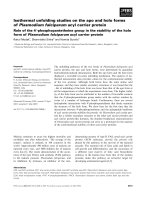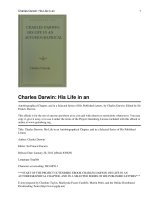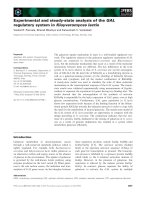What is called the 4 point system in fabric inspection
Bạn đang xem bản rút gọn của tài liệu. Xem và tải ngay bản đầy đủ của tài liệu tại đây (76.68 KB, 8 trang )
What is called the 4 point system in fabric inspection
1. Fabric Quality Inspection:
The quality of a final garment depends on the quality of a fabric when it is received
as a roll. Even the most outstanding manufacturing methods cannot compensate for
defective materials. Normally, we inspect 10% of the rolls we receive and evaluate
them based on a four-point system. This way, we can avoid fabric related quality
problems before it is put into production
2. Four- Point System:
Amount to select: Inspect at least 10% of the total rolls of the shipment.
Selection of rolls: Select at least one roll of each color. If more than one roll must
be selected, then choose the additional rolls in proportion to the total number of
rolls per color received.
3. Defect Classification (Four- Point System):
Size Defect Penalty .
3 inches or less: 1 Point
Over 3 inches, but less than 6: 2 Points
Over 6 inches, but less than 9: 3 Points
Over 9 inches: 4 Points
The length of the defect is used to determine the penalty point. Only major defects
are considered. No penalty points are assigned to minor defects. (A major defect is
any defect that would cause a final garment to be considered a second.)
4. Major Defects:
· Major woven fabric defects include but are not limited to slubs, holes, missing
yarns, yarn variation, end out, soiled yarns, and wrong yarn.
· Major dye or printing defects are out of register, dye spots, machine stop, color
out, color smear, or shading.
5. Acceptance Criteria and Calculation:
· 40 points per 100 yards is the acceptable defect rate
· # of Points per 100 yds = # of penalty points x 100
Yds inspected
6. Inspection Procedure:
· Determine the amount to inspect 10%).
· Select the rolls to inspect.
· Put the rolls on the inspection machine or other viewing device.
· Cut off a 6 inch piece across the width off the end of the roll. Mark the right and
left side of the strip. Stop the inspection process every 50 yards and use the strip to
check for any shading problems. Also make sure to check the end of the role.
· Inspect for visual defects with the light on at a speed slow enough to find the
defects. (The fabric must be checked at a slow rate in order to effectively find
flaws). Sometimes you may have to turn the light off to see how a flaw will affect
the appearance of a garment.
· Check that the roll contains the correct yardage as stated by the piece goods
source.
· Check for skewed, biased, and bowed fabric.
· Mark any defects to the side with colored tape so that they can be easily found
and noted.
· Record any defects.
Guidelines to INSPECTION SYSTEM - “ 4 - POINT “ SYSTEM
The Four-point system will be used to determine the lot acceptance of fabrics for
adidas-Salomon. This numeric grading system is endorsed by the American
Society for Testing and Materials (ASTM), The American Apparel Manufacturers
Association (AAMA) and the European Clothing Manufacturing Association
(ECMA).
A) Demerit points shall be assigned as follows (Defects in any direction):
1 point - Defects of size exceeding 0 inches but not exceeding 3 inches (7.5cm)
2 points - Defects of size exceeding 3 inches (7.5cm) but not exceeding 6 inches
(15cm)
3 points - Defects of size exceeding 6 inches (15cm) but not exceeding 9 inches
(22.5cm)
4 points - Defects of size exceeding 9 inches (22.5cm)
B) No yard shall be penalized more than 4 points.
C) All holes regardless of size, shall be penalized 4 points. There must be two or
more yarns broken at the same place, for the defect to be considered a hole.
D) No piece shall be accepted as first quality where the usable width (which is the
width between the insides of the selvages or between the stenter pinholes) is less
than the minimum usable width stated on the purchase agreement. Unless
otherwise stated, the fabric width specified on the adidas-Salomon material
specification sheet is for minimum fabric width, measured inside the selvages.
E) No piece shall be accepted as first quality that exhibits a noticeable degree of
shading from side-to-side or side-to-center.
F) No piece shall be accepted as first quality exhibiting a noticeable degree of
shading end-to-end, when checked by laying panels, cut from the beginning of the
roll, across the opposite end.
G) Fabric bowing or bias should be within the following tolerances.
i) Yarn-dyed in checker pattern: No piece shall be accepted as first quality
exhibiting more than 1.5 inches (3.8 cm) of bow or bias on 60 inch (152cm) goods.
ii) Printed in checker or stripe pattern: No piece shall be accepted as first quality
exhibiting more than 1.2 inches (3cm) of bow or bias on 60 inch (152cm) goods.
iii) Single jersey knitted fabrics within 5%. Note that fabric should be within 5%
skew after washing.
H) No piece shall be accepted as first quality exhibiting a noticeable degree of
looseness (waviness) or tightness along either or both selvages, nor ripple or
puckers within the body of the fabric, which would prevent the fabric from lying
flat when spreading in a conventional manner.
J) Any defect found to repeat and or run in a continuous manner will constitute a
running defect.
i) Any piece having a running or repeating defect through more than three (3)
continuous yards shall be rejected regardless of the point count.
ii) More than one occurrence, in excess of three (3) yards, in an audit can cause the
dyelot to be rejected.
FABRIC STANDARDS CLASSIFICATION CONT . . .
K) If the total number of second quality yardage is 20% of the total inspection
quantity, the dyelot fails inspection pending adidas-Salomon’s instructions, as to
the disposition of the shipment. The following types of defects are included:
a) Bowed or bias in excess of stated tolerances.
b) Dye streaks or unevenness.
c) High point count.
d) Hand-feel too stiff or soft compared with standard.
e) Loose, wavy or tight selvages.
f) Narrow width.
g) Shading side-to-side or side-to-center.
h) Shaded end-to-end.
i) Any combination of the above.
Note that for defects such as bowing or bias, incorrect hand-feel, narrow width,
and side-to-side/side-to-center/end-to-end shading no penalty points shall be
assigned. However, the entire roll shall be graded as second quality and should be
rejected.
At the discretion of adidas-Salomon or their appointed garment supplier, the fabric
supplier may be required to re-evaluate the entire shipment, remove and/or re-
evaluate defective rolls, and re-offer the shipment for re-inspection.
L) Individual pieces and dyelots shall be rejected if their point levels exceed those
of the classified groups, listed below, based on 100 linear yards:
Fabric Classification
Individual roll
(max. points per 100 lin yds)
Shipment
(max. points per 100 lin.yds)
Group 1
15 points
12 points
Group 2
25 points
20 points
M) If the actual fabric length of a piece is significantly more or less than the length
recorded on the piece
ticket, penalty points will not be assigned for the roll length variation. However,
the discrepancy will be
recorded on the fabric inspection report.
N) All bulk dye lots should be consistent with the adidas color standard and
approved lab dip. Please refer to the adidas-Salomon color manual for detailed
information.
O) If there is more than one dye lot for any color, in a fabric shipment, the mill is
responsible for ensuring that
the color consistency between dye lots is within an acceptable range, compared
with the first bulk approved
colour swatch and adidas-Salomon color standard.
P) For denim, a certain amount of skew is required to be added to the fabric in the
finishing process. Please check with the respective LO Quality Manager to
determine how to measure the fabric skew.
Q) All rolls of fabrics should be within +/-5% of the given weight specification,
measured according to Determination of Fabric Weight g/m2 ISO3801/ASTM3776
(adidas modified) method. (Refer to section 4.19 Apparel Materials Test
Procedures & Requirements Manual).
FABRIC STANDARDS CLASSIFICATION CONT . . .
2. SAMPLING SIZE
The ability to sample sufficient rolls of fabric will depend on the type of facilities
and equipment that the fabric and apparel suppliers have available. However, it is
recommended that the following sampling procedures be used:
By Material Supplier
A) Any Shipment lot - 100% inspection
By Apparel Supplier
A) Shipment of 1,000 yards or less - 100% inspection
B) Shipment of 1,001 yards or more - 10% inspection (minimum 1000 yards)
3. DEFECT CLASSIFICATION
Please refer to ASTM D3990-99 Standard Terminology Relating to Fabric Defects
for an explanation of different types of defects found in knit and woven fabrics.
4. IN-COMING INSPECTION BY APPAREL SUPPLER
With the introduction of Lean practices at all adidas-Salomon suppliers, it is
important that a Right-First-Time approach is indoctrinated at each level of the
production process. The expectation of the apparel supplier is that all materials
reaching them have zero or minimal defects. Unfortunately, material manufacturers
are currently not achieving such a level of excellence, so the apparel supplier still
needs to inspect and replace defective parts before submitting cut panels to the
sewing line.
All in-coming materials to the apparel supplier must be inspected, unless they have
sufficient confidence in the ability of their material suppliers to mark or tag defects
or to produce quality fabrications. It is also recommended that apparel suppliers set
up a process of panel inspection to replace any defective parts, before the cut
panels are sent to the sewing section.
PART 2: FABRIC INSPECTION PROCEDURES
A. INTRODUCTION
This section is written to provide a general guideline on the fabric inspection
procedure, so that fabric mills and garment suppliers can conduct the inspection
process in a similar way.
In our quest for the continuous improvement of garment quality, we believe that
the inspection of the piece goods and the subsequent improvement of fabric quality
are important steps in the continuous improvement process.
It is recognized that there are several piece goods inspection systems, but in order
for our garment suppliers to communicate any problems to our fabric suppliers, it
is important that a common procedure be used. For this reason, adidas-Salomon
has chosen to use the 4-point system, as the common system.
This procedure will allow our suppliers to evaluate the conformity of production
fabric and/or approval samples against adidas-Salomon minimum requirements,
through the visual inspection of fabric rolls, randomly selected from a shipment
lot.
B. INFORMATION REQUIRED FOR FABRIC INSPECTION.
· ASTM D3990-99 Standard Terminology Relating to Fabric Defects
· Approved first bulk fabric swatch(es) for each color and adidas-Salomon color
standard
· Color continuity card (showing previous dye lots, refer to Appendix 2 for
example of form)
· Packing list from mill
· Blank inspection report form
· adidas-Salomon fabric inspection procedures.
C. INSPECTION METHODS
USING A FABRIC INSPECTION MACHINE
· All fabrics are to be inspected on an inspection machine. The inspection machine
should have a variable speed motor and a mechanical counter for measuring roll
lengths. During the inspection, the inspector must stand at an appropriate distance
from the machine to ensure the best viewing position to observe both fabric color
shading and mill defects.
· The frame should be tilted so that the fabric passes at an angle of between 45 and
60 degrees to the horizontal. The frame is to be illuminated with a minimum of two
F96 CWF (Cool white fluorescent) bulbs, positioned parallel to each other and
perpendicular to the direction the fabric is moving.
· The fabric should be inspected at a speed that is compatible with the inspector’s
ability and the type of fabric being audited. The appropriate inspection speed
should be determined by the inspector, but should never exceed twenty-five (25)
yards per minute.
· All material suppliers are required to provide a suitable and safe area for
conducting fabric inspection. This area should be separate from the fabric finishing
department and equipment. The mill should also provide appropriate personnel to
load and unload the inspection machine, whenever adidas-Salomon QC or
appointed garment suppliers are conducting an inspection.
D. FABRIC INSPECTION PROCEDURES-INSPECTION
This procedure is for a fabric inspection conducted by the apparel supplier or a
third party at the mill. The apparel supplier for incoming shipments can also use
most of the steps. A physical inspection will generally cover the following
procedures.
a) Record the inspected roll details (piece length/piece number/dye lot number) on
the inspection form.
b) At the beginning and end of each roll, a 6-inch wide full width sample should be
cut, as a color reference and used to assess side-to-side, side-to-center, end-to-end
and roll-to-roll shading.
c) Check the fabric weight (refer to section 4.19 Apparel Materials Test Procedures
& Requirements Manual).
d) The fabric width should be checked a minimum of three times during the
inspection of a roll (at the beginning, middle and end). The definition of cuttable
fabric width is the measurement excluding the fabric selvages or the fabric outside
the tenter pin marks, the unprinted, uncoated or otherwise untreated surface portion
of the fabric.
e) Record the fabric length (by mechanical counter).
f) During inspection, the location of the defects should either be flagged, with a
plastic barb at the selvage, or marked with a defect sticker. Whether to flag defects
and how to flag defects should be discussed and agreed upon between material
supplier and garment maker. For example, some delicate fabrics should not have
defects tagged with barbs as it can cause more damage to fabric in shipping and
handling.
g) Record the point count and type of weaving or finishing defects on the
inspection form.
h) Calculate the total penalty points per 100 linear yards, by individual roll.
i) Calculate the average penalty points per 100 linear yards for the entire shipment.
j) Complete the inspection report and determine acceptance/rejection of the
shipment or whether it is necessary to hold.
k) Review the results and any defective samples with the supplier.
l) If the supplier agrees the result, they need to confirm by signing the inspection
report.
m) If the shipment is rejected or placed on hold, some defective samples should be
immediately brought back to the office, to review with appropriate parties. Bulk
sample swatches from each dye lot should be attached to a color con









